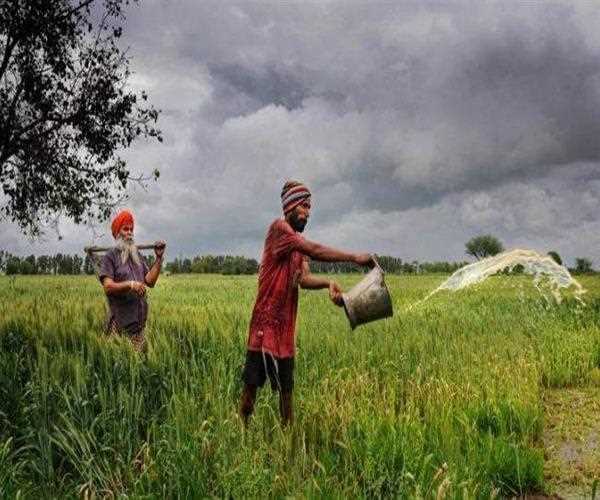Search here

21-Apr-2020
Only Farming Can Save Indian Economy
Due to the lockdown, there is a single greatest need for people locked in their homes across the country. That is food, and that too not once, but three times. Whether it is a rich man, who sits comfortably in his home, finds ways to make different dishes every day, or a poor man, who extracts edible bananas from a pile of rotten bananas thrown along the Yamuna, food is the basic necessity of man is. The repeated adage that agriculture is the mainstay of the Indian economy in this difficult time of lockdown — is not only more clear, but it has gained further significance.
But imagine what chaos this will cause if the country does not have enough food grains in this challenging time. Imagine what would have happened if we had kept a stock of food grains equal to 20 percent of our population, following the advice of mainstream economic experts. Imagine what would have happened if the APMC mandi had been dissolved and the process of government procurement of food grains had ended.
A study shows that 96 percent of migrant laborers have not received ration despite having more than three times the grain stock of our national requirement. After the lockdown, the number of starving and thirsty laborers who traveled to their village on foot for hundreds of thousands of kilometers was a realization of the crisis that has been going on for decades. The manner in which laborers moved from cities to villages in times of crisis, and the way the state governments arranged food and camps for those stranded, drew our attention to an existing, but hidden aspect of the agrarian crisis. Does.
Indeed, the cities refused to accept the laborers from the villages and clearly maintained a dividing line. In such a situation, when the chain of daily wages was broken due to lockdown, the workers found themselves isolated. A large number of workers who have returned to the village are yet to return to the city for employment. He decided to return to the village in difficult times so that he would not go hungry eventually among his family. This fact only tells about our inconsistent economic thinking.
Apparently, a large number of people were evacuated from the villages to the cities, as cities needed cheap labor. Keeping the price of agricultural products low on the one hand and keeping food inflation under control, on the other hand, by providing cheap raw material to the industries, the agricultural sector was deliberately given lower status. Farmers are producing record grains year after year despite depriving farmers of their fair price. It is not a coincidence that the lockdown occurred at the same time as the harvesting time of the rabi crop. This year the crop was expected to be high despite the unseasonal rains.
But since people are locked in homes, and restaurants, hotels, and dhabas are closed, there is no demand for perishable vegetables and fruits. There have been reports of farmers running the plow again in fields filled with cabbage, cauliflower, radish, peas, and other vegetables. Farmers dumped tomatoes in their fields. Strawberry cows were fed and the mushrooms rot. The price of Alphonso mangoes, grapes, bananas, coffee, tea, cashews, and spices fell. Poultry producers suffered the most. The milk, fish and flower markets were also significantly affected. The shortage of agricultural laborers has deepened the current crisis. Production of wheat is said to be a record of 10.6 million tonnes this time, but the lack of farm laborers will affect the harvesting of wheat.
However, for practical reasons, the government has kept agriculture, horticulture, plantation crops, fisheries, and animal husbandry out of lockdown from today, and wheat procurement has also started slowing down. But despite the agriculture sector being severely affected in the first round of lockdown, it is being said that the situation in the agricultural sector is comparatively better. Barring this crisis, the big question is whether this epidemic will change our outlook on the agricultural sector.
In the agriculture sector which employs 50 percent of the population, the public sector investment between 2011-12 to 2017-18 was 0.3 to 0.4 percent of GDP. As agriculture is emerging as a strong pillar of the economy in this time of crisis, the effort to marginalize agriculture would be politically suicidal. While there is a need for massive changes and huge investment in the agricultural sector, it will be a challenge to provide remunerative prices and monthly income to the farmers.
A study by the OECD (Organization for Economic Co-operation and Development) shows that Indian farmers lost Rs 45 lakh crore between 2000 and 2016-17 due to a lack of fair value for their crops. If the farmers had got this money, which sits at 2.6 lakh crores annually, then people would not have left the farming and migrated to the cities. After Kovid-19, our goal should be the development of all along with everyone and everyone's faith. This is not optimistic thinking. This is an idea whose time has come. (The author is an agricultural policy expert.)

Content Writer/Journalist
I am a content writter !
Join Our Newsletter
Subscribe to our newsletter to receive emails about new views posts, releases and updates.
Copyright 2010 - 2025 MindStick Software Pvt. Ltd. All Rights Reserved Privacy Policy | Terms & Conditions | Cookie Policy